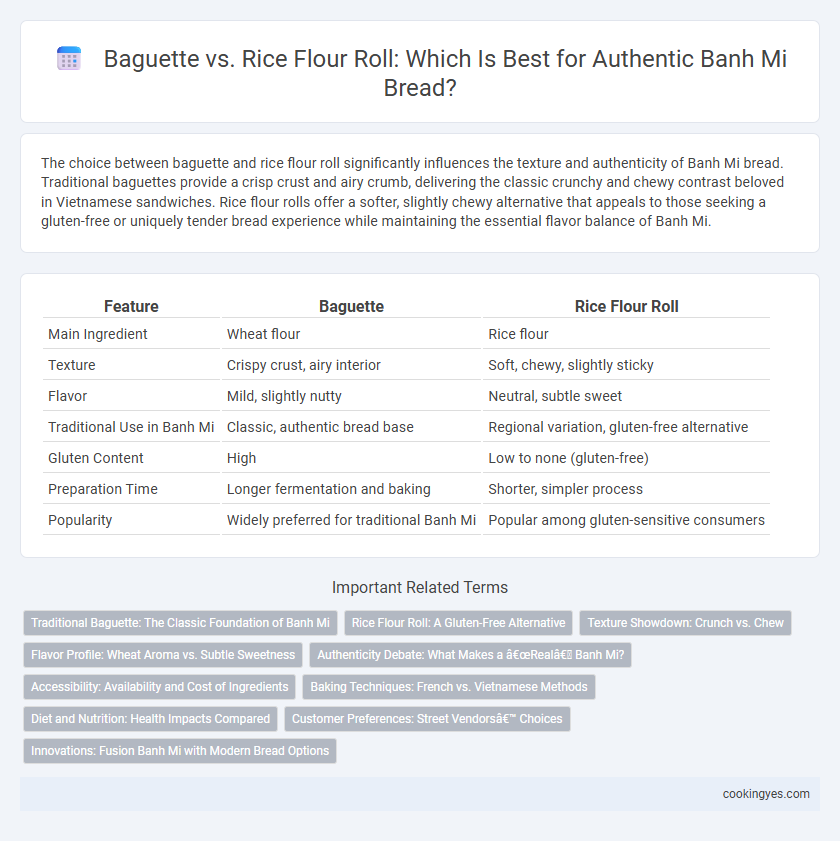The choice between baguette and rice flour roll significantly influences the texture and authenticity of Banh Mi bread. Traditional baguettes provide a crisp crust and airy crumb, delivering the classic crunchy and chewy contrast beloved in Vietnamese sandwiches. Rice flour rolls offer a softer, slightly chewy alternative that appeals to those seeking a gluten-free or uniquely tender bread experience while maintaining the essential flavor balance of Banh Mi.
Table of Comparison
| Feature | Baguette | Rice Flour Roll |
|---|---|---|
| Main Ingredient | Wheat flour | Rice flour |
| Texture | Crispy crust, airy interior | Soft, chewy, slightly sticky |
| Flavor | Mild, slightly nutty | Neutral, subtle sweet |
| Traditional Use in Banh Mi | Classic, authentic bread base | Regional variation, gluten-free alternative |
| Gluten Content | High | Low to none (gluten-free) |
| Preparation Time | Longer fermentation and baking | Shorter, simpler process |
| Popularity | Widely preferred for traditional Banh Mi | Popular among gluten-sensitive consumers |
Traditional Baguette: The Classic Foundation of Banh Mi
Traditional Banh Mi bread relies on a classic French baguette characterized by a crisp crust and airy, chewy interior, providing the essential texture that complements the sandwich's diverse fillings. Unlike rice flour rolls, which tend to be softer and denser, the French baguette's unique gluten structure allows it to hold pickled vegetables, meats, and pate without becoming soggy. This time-honored use of the baguette not only preserves Banh Mi's authentic taste but also highlights the fusion of Vietnamese ingredients with French baking techniques.
Rice Flour Roll: A Gluten-Free Alternative
Rice flour rolls offer a gluten-free alternative to traditional baguettes in Banh mi, catering to those with gluten sensitivities or celiac disease. These rolls maintain a soft, chewy texture that complements the savory fillings while avoiding the gluten proteins found in wheat-based baguettes. Incorporating rice flour enhances digestibility and provides a unique, slightly sweet flavor that differentiates it from conventional Banh mi bread options.
Texture Showdown: Crunch vs. Chew
Banh mi bread made with traditional baguette flour boasts a crisp, crunchy crust that contrasts delightfully with its airy, soft interior. In comparison, rice flour rolls offer a chewier texture with a slightly denser bite, enhancing its moistness and elasticity. This texture showdown between crispy baguette and chewy rice flour roll significantly influences the overall eating experience and authenticity of the iconic Vietnamese sandwich.
Flavor Profile: Wheat Aroma vs. Subtle Sweetness
Banh mi made with traditional baguette bread offers a distinct wheat aroma and a crisp texture that enhances the sandwich's savory fillings. In contrast, rice flour rolls provide a subtle sweetness and a softer bite, complementing the balance of pickled vegetables and fresh herbs. Choosing between wheat-based baguette and rice flour roll significantly influences the flavor profile and overall eating experience of authentic Vietnamese Banh mi.
Authenticity Debate: What Makes a “Real” Banh Mi?
The authenticity debate over Banh Mi bread centers on whether a traditional French-style baguette or a rice flour roll best represents the "real" Banh Mi. Classic Banh Mi uses a light, airy baguette with a crispy crust achieved through a combination of wheat and rice flour, which differentiates it from a standard French baguette. This hybrid texture and flavor balance are key elements purists argue define an authentic Banh Mi experience.
Accessibility: Availability and Cost of Ingredients
Baguette-based Banh mi bread relies on wheat flour, which is widely available in many regions but may have higher costs due to import or processing fees. Rice flour rolls offer greater accessibility in Southeast Asia, where rice is a staple crop, making ingredients more affordable and locally sourced. Choosing between the two depends on balancing ingredient availability and cost efficiency for authentic Banh mi preparation.
Baking Techniques: French vs. Vietnamese Methods
French baguettes for Banh mi utilize high-gluten wheat flour and steam injection in ovens to create a crispy, airy crust with open crumb structure, emphasizing traditional French baking precision. Vietnamese rice flour rolls incorporate a blend of rice and wheat flours, leveraging rice's gluten-free properties to produce a lighter, chewier texture through techniques like hand shaping and moderate fermentation. The contrast between the French method's focus on crust development and the Vietnamese approach to soft crumb adaptability highlights the cultural fusion embodied in Banh mi bread.
Diet and Nutrition: Health Impacts Compared
Baguette-based banh mi bread is typically made from refined wheat flour, providing higher gluten content and a chewier texture but also a higher glycemic index, which may cause quicker blood sugar spikes. Rice flour rolls, often used as a gluten-free alternative, tend to have lower gluten and a slightly lower glycemic index, potentially benefiting those with gluten sensitivities or seeking more stable blood sugar levels. Nutritionally, rice flour rolls are generally lower in protein and fiber compared to traditional baguettes, impacting satiety and muscle repair benefits.
Customer Preferences: Street Vendors’ Choices
Street vendors commonly favor traditional baguettes for Banh mi due to their crispy crust and airy texture, which complement the sandwich's vibrant fillings. Some vendors experiment with rice flour rolls to cater to gluten-sensitive customers, offering a softer, chewier alternative with a subtle sweetness. Customer preferences often drive these choices, with baguettes remaining dominant in urban markets and rice flour rolls gaining popularity in health-conscious or specialty street food scenes.
Innovations: Fusion Banh Mi with Modern Bread Options
Innovations in Banh Mi bread incorporate fusion techniques by blending traditional French baguette textures with modern rice flour rolls, offering gluten-free alternatives that maintain the sandwich's signature crunch. Rice flour rolls provide a lighter, chewier texture while preserving the crisp exterior characteristic of classic baguettes, enhancing the overall eating experience. These modern bread options expand the versatility and accessibility of Banh Mi, catering to diverse dietary preferences while respecting its cultural roots.
Baguette vs rice flour roll for Banh mi bread Infographic

 cookingyes.com
cookingyes.com